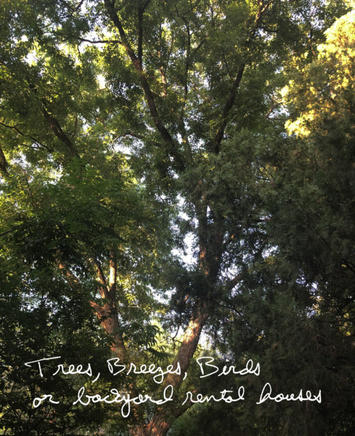
The Dallas city manager and housing director are proposing a devastating blanket zoning change: allowing ADUs (additional dwelling units), better known as backyard rental houses, in single-family zoned neighborhoods. This change would allow a 44-foot wide by 30-foot tall rental house to be built on the back of a standard 50‑foot wide by 150-foot deep lot. Backyard rental houses would deforest the older neighborhoods, undermine neighborhood stability, accelerate gentrification, reduce diversity of housing, and diminish attainably priced opportunities for homebuyers.
The Older Neighborhoods of Dallas Are Green While Other Cities Are Dense
The life force of Dallas is its original neighborhoods, which have layers of towering trees, lush landscape, gardens, and a natural habitat for wildlife and singing birds. This is in contrast to most cities where urban planners strive to make cities denser and grittier, with neighborhoods geared towards mass transportation. In Dallas life is more pleasant. One can still stroll through shaded neighborhoods and easily drive five or ten minutes to favorite destinations.
Dallas continues to rapidly evolve in a positive way. However, allowing backyard rental houses to be built would derail the distinguishing characteristics and lovely momentum of Dallas’ older neighborhoods. The city manager and housing director are soft-pedaling backyard rental houses as just adding “gentle density,” “granny flats,” “mother-in-law suites,” and “ADUs” to increase affordable housing in Dallas’ finest neighborhoods.
Backyard Rental Homes Will Replace 80′ Trees
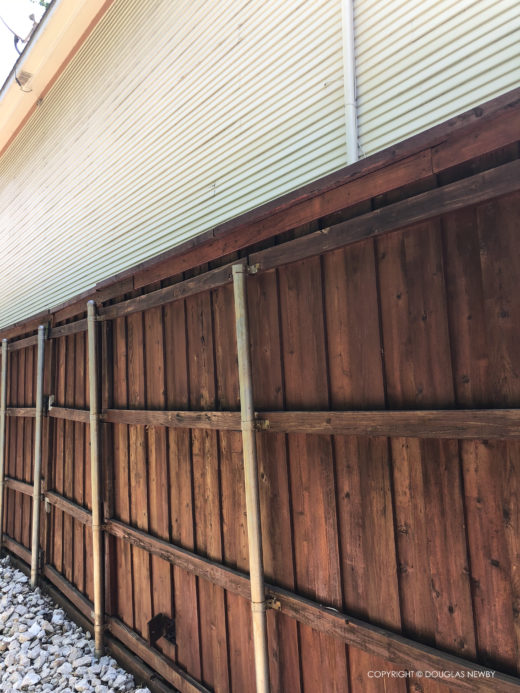
This 40-foot two-story structure replaced an 80-foot tall, 100 year old tree. It is a several bay garage with a large storage space above. It is not a rental house, but shows the mass on a 50-foot wide lot.
This option is not gentle. There are no proposed limits on the number of these backyard rental houses allowed in any neighborhood. They will replace 80-foot tall pecan trees and other mature trees in backyards and disrupt the positive direction of older neighborhoods.
Adding Density Erodes Prices of Homes
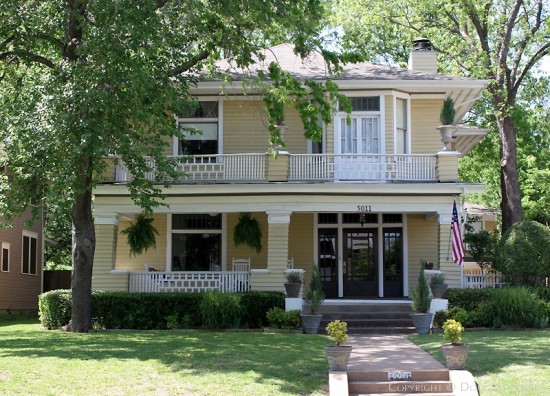
5011 Junius Street sold for $10,500 in 1907 and after density was added to the neighborhood it resold 70 years later, in 1977, for $7,500.
Over the decades, economic studies have shown that adding multi-family zoning and density decrease the prices and stability of neighborhoods. While absentee owners find two houses on a lot more attractive, homeowners find this less attractive.
Density Was Added to Munger Place – Value Subtracted
An interesting case study is Munger Place. In 1905, it was the finest residence park in the South, at a time when Highland Park was struggling. “Gentle density” was added—rooming houses, apartments carved out of single-family homes, and ultimately apartment zoning. By 1974 the City of Dallas Housing Report identified Munger Place as the worst neighborhood in Dallas with the highest disease rate, the highest murder rate, the greatest number of homes being demolished, the most transient population, the highest crime rate, and no building permits issued for new homes for the past several years. The added density and resulting transience had a profound negative effect. A home at 5011 Junius in Munger Place that sold in 1907 for $10,500 resold in 1977 for $7,500—a 30% decline over 70 years.
City Planners Have Love Affair With Density for Density’s Sake
Despite the economic havoc that adding density and increasing multi-family zoning has had on older neighborhoods, the call to add density in the inner city neighborhoods is not new. For 75 years urban planners have been pushing for more residential density in cities. Rooming houses became common in the 1940s. In the 1970s, mixed use zoning became the zoning du jour. In the past several years, ADUs in backyards have been the latest academic, avant-garde, urban planner movement.
Backyard Rental Houses Accelerate Gentrification
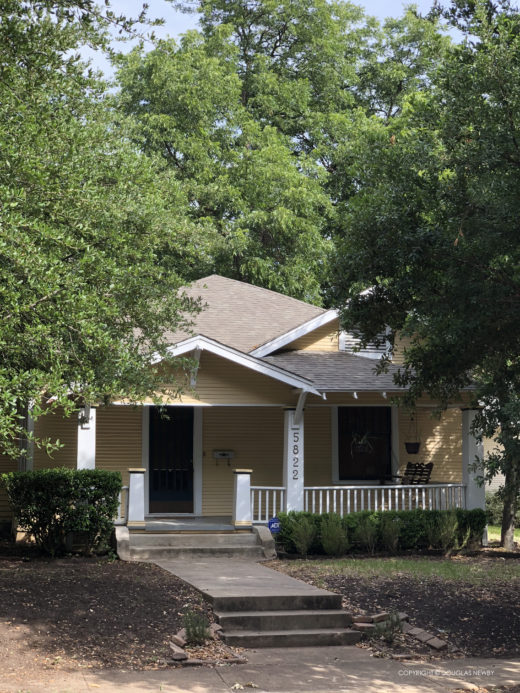
Craftsman cottages are small houses framed by large backyard trees. Neither will likely not survive with backyard rental house zoning in place.
Urban planners claim that by adding backyard rental houses gentrification will be slowed, there will be more affordable housing in improving neighborhoods, and seniors will be better able to afford to stay in their homes. An example of this national infatuation for increased neighborhood density is seen in the recent New York Times June 13th op-ed column by Diana Lind, Bring Back Rooming Houses. Lind writes, “We need to disrupt the model of single-family homes.” She also says, “A font of affordable housing exists.” She explains, “It is the wasted space of single-family homes … backyards … that could be zoned as shared space.” Lind mentions that some forward-thinking cities get it.
Backyard Rental Houses Encourage Landlords to Replace Homeowners
I, on the other hand, do not think her ideas are forward-thinking. While she thinks backyards are wasted spaces, I think they are an oasis of trees. Rental houses built in the “wasted spaces of backyards” will deforest the older neighborhoods and accelerate gentrification.
Backyard rental houses and increased density encourage landlords to replace homeowners and concrete to replace streets. This has a domino effect. Neighborhoods have either a positive or negative effect on each other. For instance, Highland Park has even benefited from the resurgence of the bordering Dallas tree-lined neighborhoods.
Attainably Priced Houses Are Reduced, Gentrification Increases
In addition to economically and aesthetically disrupting the neighborhoods, backyard rental houses accelerate gentrification and reduce the attainable priced options for homebuyers.
Rental House Loans Hurt Seniors, Not Investors
The city planners claim that seniors can offset the cost of their homes and remain in their homes longer by building backyard rental houses. This is not economically accurate. First, building a small rental house is very expensive per square foot. We have seen this on the cost of the 400 sf homeless cottages built in Dallas. Their construction cost was well over $200/sf. The 700 sf backyard rental house would cost approximately $200,000 or $300,000 if it was built over a three- or four-car garage.
Seniors Want Simpler Lives, Becoming Landlords Complicates Lives
Seniors, who probably want simpler lives, would become landlords with all the accompanying headaches that it entails, responsibilities, liabilities, and pressure of keeping it rented to pay off their $200,000 to $300,000 loans.
Backyard Rental House Removes A Senior Tax Freeze
But that’s not the worst of it. Once a new rent house is built, the tax freeze is taken off the house. The original house is reappraised for its full value and the value of the backyard rental house is added. A new senior tax freeze is reset but at a much higher amount. If seniors want to get into the rental business to offset their own home costs, they would be better off keeping the tax freeze in place on their homes and buying $200,000 rent houses nearby. If they had any cash flow beyond the cost of their loan, they could then apply that to the operating costs of their own home.
Backyard Rental Houses Lower Number of Affordable Rents
Also, the backyard rental house plan does not net more affordable apartments for renters. For instance, Mt. Auburn is a neighborhood just eight blocks away from the $2 million homes on Swiss Avenue. Here, one can purchase a 1,150 sf home for $175,000. These homes are 50% larger than a new 700 sf backyard rental house which would have a higher monthly rental rate because they are new. There will also be investor pressure to buy the $175,000 Mt. Auburn house because they can now build two houses on its lot.
Small Houses Will Be Torn Down for Investor Template of 2,800 sf Main House and 700 sf Rental
Investors would be given an incentive to tear down the existing home and build a 2,800 sf $700,000 house. This is the minimum square footage they would need in order to build a 700 sf rental house in the backyard. The result is a $700,000 home replaces an attainably priced $200,000 home, and the backyard rental house costs more to rent per month than did the original $175,000 home. In fact, there would be an incentive to make all the neighborhoods a template of 2,800 sf main houses and 700 sf backyard rental houses.
Junius Heights-Style Homes With 1,800 sf Also In Jeopardy

Junius Heights cottages will be candidates for expansion to 2,800 sf to allow 700 sf backyard rental houses, replacing trees as pictured.
In Junius Heights, adjacent to Swiss Avenue, the 1,800 sf houses cost $300,000 to $450,000—still attainable prices for many homeowners. By allowing backyard rental houses, these Junius Heights homes would also become targets for investors. Investors would add 1,000 sf to these 1,800 sf. homes to make them 2,800 sf, allowing them to build the maximum 700 sf rental house in the backyard.
City Planners’ Template of 2,800 sf Main House/700 sf Rental Destroys Diversity of Housing
The backyard rental house proposal, if enacted, would make all the older Dallas neighborhoods susceptible to the investor/builder template of 2,800 sf main houses and 700 s. backyard rental houses. Along with mature trees, the rich diversity of housing, sizes, prices, and architectural styles is lost forever.
Backyard Trees Soften Retail Streets
The backyard rental house proposal does more than just disrupt the economic stability and housing diversity in the older neighborhoods known for their tree-lined streets, such as Old East Dallas, North Oak Cliff, and South Dallas. They are also known for their even larger trees that are clearly visible behind the houses, and it is not just the residential neighborhoods that benefit from these tall trees, but the retail streets in these neighborhoods.
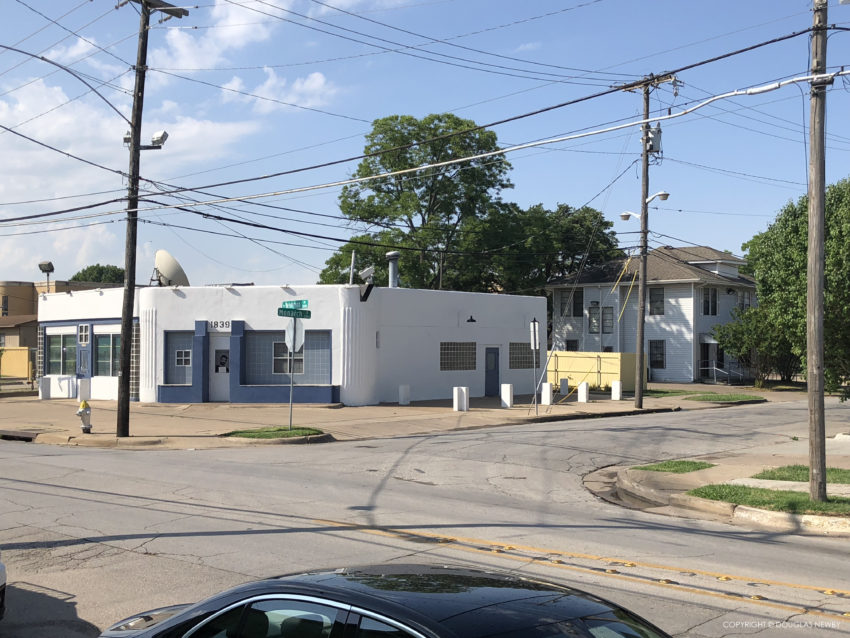
From Houndstooth coffee house one can see Louie’s Bar with 70 foot tree in neighbor’s backyard.
Henderson Avenue Benefits From Backyard Trees
Henderson Avenue is a vibrant street of retail, restaurants, and grocery stores that leads to Ross Avenue and Lower Greenville Avenue. Softening this neighborhood commercial street are 80-foot tall trees, like those one can see from Houndstooth Coffee, located on Henderson Avenue. These are found behind the 100-year-old residences beyond Henderson, like this one on Monarch Street behind Louie’s Bar and Restaurant. The mature trees in the backyards of the houses abutting the commercial uses are what give Henderson a neighborhood feel. Otherwise, we might as well be in the commercial districts of the West End, Deep Ellum, or Uptown.
Global Warming, Pestilence, Neighborhood Ecosystem Disrupted
The loss of trees is more than just an aesthetic loss. Backyard rental houses contribute to global warming, invite pestilence, and disrupt the environmental ecosystems of the neighborhood urban gardens.
Global Warming
A canopy of trees keeps homes cooler, requiring less air conditioning. Shaded backyards with unblocked breezes cool the yards and porches, encouraging homeowners to spend time outside, and reducing the amount of air conditioning needed inside. The rooftops and concrete that replace these backyard trees collect heat and radiate that heat outward to the neighboring homes, neighborhood and city.
Pestilence

West Nile Mosquitoes Do Not Like Density
The summer breezes that flow through the trees have more than just a cooling effect. Breezes are the best defense against the small West Nile Virus-carrying mosquito. The large field mosquito can fight through the wind. The West Nile mosquito likes still air in highly developed areas, breeding in bottle caps and other small amounts of water. The breezes and open areas make East Dallas much safer than neighborhoods like North Dallas, with larger footprints of homes and development. Backyard 40-foot wide rental houses on 50-foot wide lots block any breeze. These backyard rent houses invite the West Nile mosquito.
Environmental Impact

Cooper’s Hawks in backyards cause an ebb and flow with a variety of songbirds that return when hawk leaves.
In the older neighborhoods of Dallas, with layers of flowering trees, one will see Cooper’s hawks, egrets, and owls. Also seen are songbirds of many varieties, pollinating hummingbirds, bees, and butterflies, along with much wildlife. This natural environment and rich ecosystem is eradicated with backyard rental houses.
Density Creates Dire Consequences
Adding backyard rental houses might sound like a short-term solution, but it would have negative short-term and dire long-term consequences. As cities around the world become more prosperous, they become less dense. Both homeowners and apartment renters prefer to live in single-family home neighborhoods.
People Are Flocking to Cities Without Density
The people in denser cities like New York and Chicago are flocking to less dense cities like Dallas. Every city has a distinct personality that should be further developed. Dallas is an open, green city that is easy to move around. Also, it is full of potential.
Employment and Housing Now Have More Flexibility
One half of the geographic area is on the south side of the Trinity River which houses only 10% of the Dallas population. This geographically beautiful part of Dallas has unlimited possibilities for affordable homes, expensive homes, and new jobs. Autonomous transportation and delivery systems will be implemented in a few years, eliminating congestion and changing development patterns and removing the need to live near places of employment. Further, 50% of workers even now can work remotely. The future evolution of technology and development will eliminate any benefit of inserting rent houses in backyards of single family homes.
Dallas Should Celebrate Its Strength – Revel in Low Density
Rather than undermining the economic and aesthetic stability of Dallas’ finest neighborhoods, inviting disease, accelerating global warming, and eradicating the rich natural ecosystem, Dallas should celebrate its strengths and potential. The finest neighborhoods are like gardens that should be tended and nourished, so they can continue to flourish. The Dallas city manager, housing director, and planning director should concentrate even more energy on revitalization, conservation, and development of the distressed neighborhoods. Rather than diminish the neighborhoods north of the Trinity River, the southern half of the city should be cultivated, planted and nourished so it, too, can flourish.
South of the Trinity River Should Be City Planners’ Playground
It is in the southern half of Dallas where there is an abundance of vacant property, deteriorating neighborhoods, and development opportunities. Many of the current avant-garde housing ideas from the 1940s can be explored—shared housing, rooming houses, adding extra kitchens and apartments within single-family homes, and allowing rent houses in backyards—in the neighborhoods that are deteriorating, being abandoned and that are ripe for new development.
It is essential we protect the positively evolving neighborhoods from more density. We do not want to destabilize the good neighborhoods by adding more apartment zoning. We do not want to return to the Dallas housing policy of the 1940s, 1950s, 1960s, and 1970s that wreaked havoc on the single family neighborhoods. Has the city of Dallas conducted a study to see how many more rental units can be built under the current zoning? How many more can be built near single-family homes?
Dallas Had Largest Multi-Family Zoned Area Rezoned Single-Family in the Country
In 1976, the largest rezoning case in Dallas history consisted of rezoning 100 blocks of 2,000 mostly rental properties from multi-family zoning to single-family zoning. This single-family rezoning was in an era when urban planners, including the award-winning ones in Dallas, were calling for more density, not less. The property owners, with the support of the property rights mayor and developer Robert Folsom, prevailed. The largest single-family rezoning in the nation passed.
FNMA Selected Munger Place for Its First Inner City Loans
Because of this single-family rezoning, FNMA selected Munger Place and Old East Dallas for its first inner city lending demonstration project. Old East Dallas gradually became more single-family. Many years later, FNMA called this neighborhood their most successful inner city lending revitalization project. Rather than return to the bad housing policies of more density and rental zoning that devastated the finest old neighborhoods of Dallas, we should embrace the single-family zoning that revitalized them and made them stronger.
Dallas Neighborhoods Become Increasingly Attractive
Our single-family zoned neighborhoods, many of them now also historic and conservation districts, are increasingly attractive to residents in Dallas and residents in the denser cities across the country that are moving to Dallas to find a home that will make them happy and to enjoy a lovelier way of life.
This piece first appeared on Dallas Architecture Blog.
Douglas Newby is a real estate broker who initiated the largest the largest rezoning in Dallas - 2,000 properties primarily in use as multi family rental properties to single family zoning. In 1979, in Dallas he created the first Restoration House of the Year Award, and for the Dallas Chapter of the AIA organized a city wide survey of architect designed and Significant homes. His TEDx talk is Homes That Make Us Happy. His website is: ArchitecturallySignificantHomes.com. Blog is DallasArchitectureBlog.com












